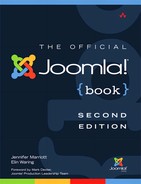Foreword to the Second Edition
There are many different books about Joomla! Some are in the form of tutorials or user manuals for Joomla! beginners. Some are more technical and go into depth about programming for Joomla! or creating templates. Who is this book for?
The Official Joomla!® Book takes a different approach from other Joomla! “how-to” books. Instead of focusing solely on using Joomla!, The Official Joomla!® Book focuses on building a real-life Web site using Joomla! If you want to buy one book to help you get your Joomla! Web site up and running from start to finish, this is the book.
It covers everything a new Joomla! user needs to know to get a real-life Web site up and running. To me, the best thing about this book—and what makes it absolutely unique—is that it includes a lot of topics not normally covered in Joomla! books.
For example, someone building a real Web site needs to think about issues like trademarks, branding, and how to plan the site. These topics are covered in Chapter 2. Most Web site publishers want their site to be as popular as possible. Chapter 9 includes important information about how to market your Joomla! Web site to the widest possible audience.
You hope your Web site has a long life. If so, it will require maintenance and updates. Chapter 10 covers how to back up your site and how to keep it up-to-date as Joomla! and your third-party extensions are updated over time.
Three chapters present practical information about the three most common types of Web sites. Chapter 11 covers Web sites for a business. This includes nuts-and-bolts information about e-commerce extensions and payment systems, shopping cart systems, and simple “brochure” sites.
Chapter 12 covers Web sites for nonbusiness organizations, such as NGOs, nonprofits, and clubs. This includes practical advice about using your organization’s Web site for creating a community, event calendars and event registration, user forums, customer relationship management, and fund-raising.
Chapter 13 covers building a Joomla! Web site for educational organizations, such as schools or universities. It includes tracking documents, calendars, contacts and faculty information, and learning extensions.
Each of these chapters includes valuable, hard-won, real-world information gleaned by the authors through their long years of experience with Joomla! Web sites. This is information that you will not find in any Joomla! documentation, tutorials, or simple “how-to” book.
Finally, the Joomla! Project is about people and community. To help bring this to life, Chapter 14 includes interviews with a number of different Joomla! community members. This helps the reader to better understand the community and how the project works (and maybe even to become a Joomla! contributor).
The second edition of this book was created to cover the Joomla! version 3.x series of releases. Version 3.0.0, released in September of 2012, was the first major release since the adoption of the Joomla! Project’s time-based release strategy. Version 3.1 will be released in March of 2013, and new 3.x releases will continue until the release of 3.5 in 2013 or 2014. At that point, version 3.5 will be the long-term-support release and will be supported by the project for at least two years.
The good news for readers of this book is that this book’s information will be current and fully relevant at least until 2015.
What is the Joomla! release cycle and how does it work? As a community-driven open source project, Joomla! must balance the needs of two different communities: users and contributing developers. Most Joomla! users want a stable, predictable release schedule. When they deploy a Web site, they want to know that the version is well tested and reliable and will have a reasonably long time between major updates.
Contributing developers are volunteers who write new features for the Joomla! core programs. The main motivation these contributors have is to see their code used. Therefore, to attract and retain these developers, it is important that their contributions be accepted and incorporated into the program on a timely basis. To do this, a relatively frequent release schedule is needed.
The Joomla! release cycle accommodates the needs of both groups by having two separate release paths. The long-term-support (LTS) path is designed to give users stable versions with relatively infrequent updates. The current LTS release at the time of this writing is version 2.5. This was released in March 2012 and will be supported until 2014, at which time users will update to version 3.5.
The standard-term-support (STS) path is designed to accommodate contributing developers. STS versions are released every six months, so new features can be rapidly incorporated into the program. This allows contributors to see their code used, which is a major motivating factor for these volunteers. The STS release path is also good for some users who require the latest feature set available.
Version 3.0, on which this edition of the book is based, is the foundation for the entire 3.x series. There will be incremental changes in future 3.x versions, but the vast majority of the information for 3.0 will be true for the entire series. Hence the timing of this edition.
Do you want to build a real-life Web site using Joomla!? If so, congratulations! You have the right book.
—Mark Dexter
Coauthor, Joomla!™ Programming
Member, Joomla! Production Leadership Team
